Palm Sunday tornadoes revealed Huffman’s strong will and steady hand
A renowned scientist pulled into a Dunlap driveway, wanting to speak to the homeowner about the infamous Palm Sunday tornadoes of April 11, 1965.
Meteorologist Tetsuya “Ted” Fujita revolutionized the study of severe storms. He developed the scale designating the strength of tornadoes. The devastation in Dunlap was a critical location for scientific study.
The person answering the door to greet Fujita may not have had equal name recognition then or now, but people around the world had seen his work, too.
When the tornadoes came down in Elkhart County that April day, The Elkhart Truth’s Paul Huffman saw it all through his camera lens. His photos were breathtaking, scary, heart wrenching, and important.
Huffman was more than a great newsman, though. With the story of his career in front of him and more mayhem coming down from the sky, the World War II veteran set down his camera to help the victims.
Always prepared
Driving home toward Dunlap on U.S. 33, Paul Huffman stopped his car. His wife, Betty, thought at first the towering black cloud must be smoke from a fire.
“He always carried a camera all the while he worked at The Truth,” Betty Huffman said in 2014. “At one time, he was on call for the whole county. He wouldn’t have gone out of the house without it.”
Paul turned to Betty and told her to run for the railroad culvert if the tornado came their way. He got out and kept himself steady in the swirling storm by swinging his leg around his car’s bumper. He snapped several frames of black-and-white 35mm film.
The Palm Sunday tornadoes arrived with fury, shattering the day that started so peacefully.
“I was so worried about him – his clothing was blowing and it was so windy and he was just snapping photos, one after the other,” Betty recounted.
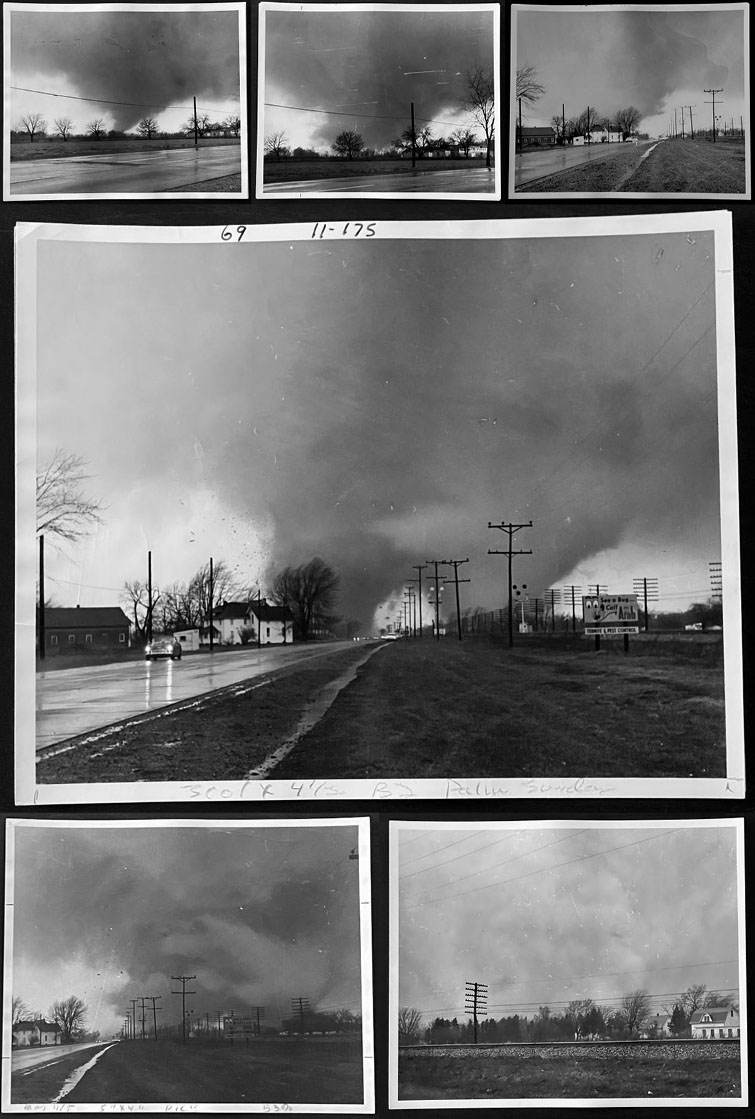
One of their sons was at home, and in the direct line of the funnels. They started the car and drove straight home. Paul made two calls – one to emergency responders to let them know what he saw, the other to his mother.
Then, he left the house.
“I actually didn’t see him for a couple of days,” Betty said. “He was out taking more photos and helping.”
Unbelievable damage
“Here it comes! Anyone who witnessed this terrifying sight of a double-headed twister swirling toward him, debris flying ahead and more being twisted up by its black funnel, would surely head for the nearest basement,” the front-page story said the next day. “The Truth photographer Paul Huffman did just that, after recording this first of the worst twisters that hit the county, about 6:30 p.m. Sunday.”
That paragraph wasn’t exactly true. The photographer later said he didn’t know he had captured the twin funnels across U.S. 33 until he developed his film that night.
Also, Huffman didn’t seek cover. He rushed toward the devastation of the Palm Sunday tornadoes.
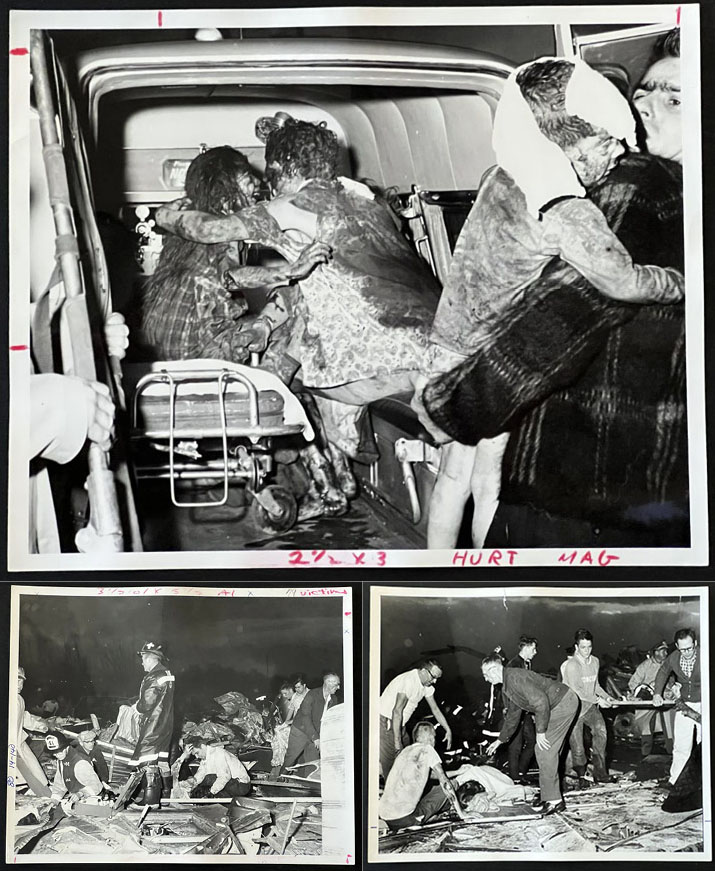
First, he drove to Midway Trailer Park, which had been demolished by the first twisters.
“There were twin funnels,” Huffman was quoted in the next day’s paper. “One came directly across the trailer court and went northeast across an open field before dropping out of sight along the old Goshen-Elkhart Road (CR 45). The extent of the damage was unbelievable. At least 100 house trailers were destroyed. They were ripped from their frames, twirled about in the air, then sent crashing to the ground.”
Here to help
It wasn’t until 1991, when Huffman retired from the newspaper, that he shared an important part of his story about that evening. Arden Erickson wrote that Huffman started helping the victims at Midway. It’s likely Paul tried to calm the survivors and move them in the direction of first responders. But like many stories lived by members of the Greatest Generation, the photographer shared no details of his selfless acts.
Then, “the second one (tornado) came,” Huffman said. “We chased that one to Sunnyside. … As it ripped down the New York Central tracks, flashes of blue light exploded in the sky as the electric wires fell. …
“I took more pictures, then ran my film to Elkhart, wrote my copy, went back and continued taking pictures. I never went to bed.”

Ten were killed by the Palm Sunday tornadoes that day at Midway Trailer Park, and 26 more perished in the Sunnyside neighborhood. The county death toll along the path of the storm numbered into the 70s. The destruction topped $25 million in damage – that’s roughly $225 million in today’s dollars.
A commitment to serve
On July 16, 1966, Huffman documented the training exercises of the Indiana National Guard in Alpena, Mich. His report was written like a serviceman, and Huffman’s joy in reporting both the flight readiness and behind-the-scenes “bull sessions” came through clearly in words and photos.
He was, after all, a man all for his country.
Huffman left high school on March 22, 1944 – a few months short of his graduation. His mother didn’t want him to go, but he enlisted in the Navy.
After training at Great Lakes and ordnance school at Naval Air Station Corpus Christi, he was ready for action. He went overseas with the VPB-100 Patrol Bombing Squadron 208, attached to the USS Hamlin.
He earned two gold combat stars and qualified for Aerial Gunners Wings while serving in the Pacific Theater.
“When he got to the service,” Betty Huffman told Truth reporter Danielle Waldron in November 2014 after Paul’s death at the age of 88, “and he was just a little guy at the time, they asked him, ‘What do you want to do?’ He said, ‘I like guns and I like flying!’ So they made him (do) both.”
‘No matter what’
With a hard-working military mindset, Huffman returned home after the war to begin his career. He married Betty in 1946 and finished his high school diploma. He worked at the Ford garage in Goshen and managed the hardware department at Montgomery Ward.
Huffman dabbled in sports announcing for WKAM-AM and advertising and circulation sales for The Elkhart Truth and Mishawaka Times. Once he came into The Truth newsroom in 1963, though, he stayed for 28 award-winning and productive years.
“He was one of those guys you could depend on and would always come back with photographs, no matter what,” said photographer Tyler Klassen, who shared the darkroom for the final few years of Huffman’s Truth career.
Through the years, Huffman’s pictures told plenty of stories. His features brightened up A.M. Magazine, a local tabloid produced for Truth weekend editions in the 1960s and ‘70s.
Telling the story
“I never thought I could go 35mm (film),” Huffman said of the transition in newspaper photography in the 1950s and early ‘60s. He was used to the big, unwieldy Speed Graphic cameras, which used 4- by 5-inch film packs. But he made his way just fine.
Photography wasn’t his sole assignment. Huffman went to the typewriter often, and his folksy style was a fine complement to his pictures.
“CRO means Car Retarder Operator. This job, on the day trick, is manned by Gene Wilson,” Huffman wrote March 1,1969, in a feature about the Robert Young Yards. “Alone in the car retarder tower, located several hundred yards down the tracks and west of the main control tower, Wilson operates a console that regulates the speed the cars travel as they come off the hump and into the classification area.
“In case of power failure, and it has happened – Wilson really has his hands full controlling the thousands of cars that enter his domain daily.”
Usually, his feature photos called for the reader to settle in and appreciate what the community had to offer.
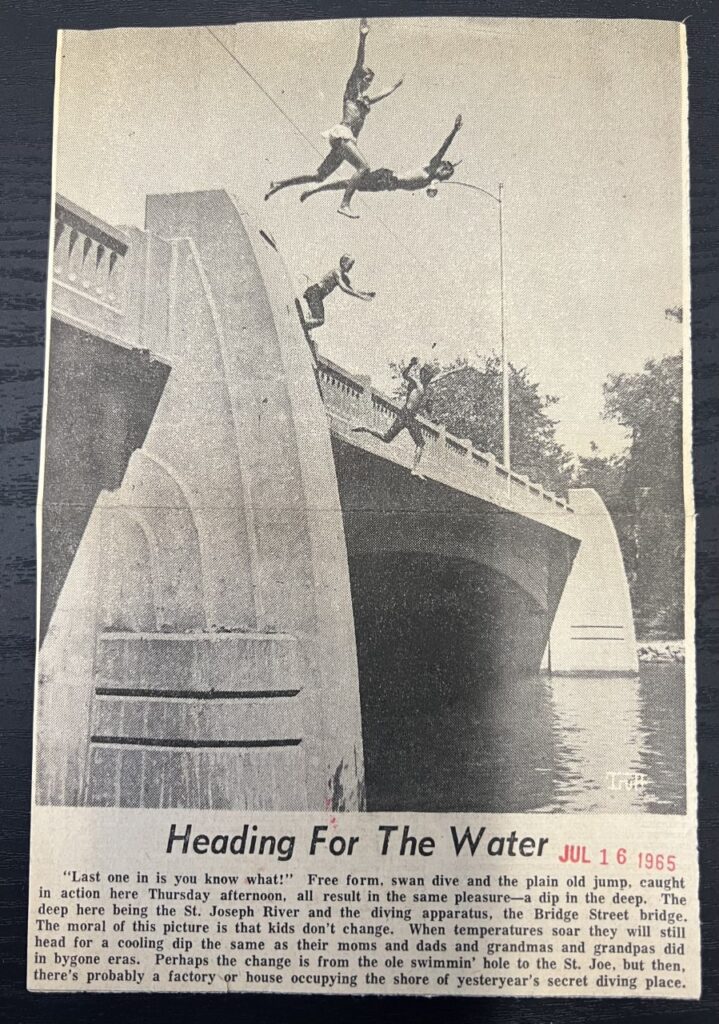
“… By day the waters of the St. Joseph River court spring with a dance of newly gained freedom,” the copy with Huffman’s March 8, 1969, photos conveyed. “But by night, while a pre-spring sun is slumbering, winter struggles to regain its grip on the truant waters. Its feeble efforts leave only teardrops behind.”
Huffman knew many ways to tell the story. He was always ready to find it, too.
Honors well earned
After the Palm Sunday tornadoes, Elkhart County Sheriff Woody Caton shared, “I saw the worst mess I have ever seen, and I went through the South Pacific during World War II. You couldn’t see where any street was. Everything was level. … People were coming out of their basements and they were staggering toward me. They had blood and dirt on their faces and couldn’t see.”
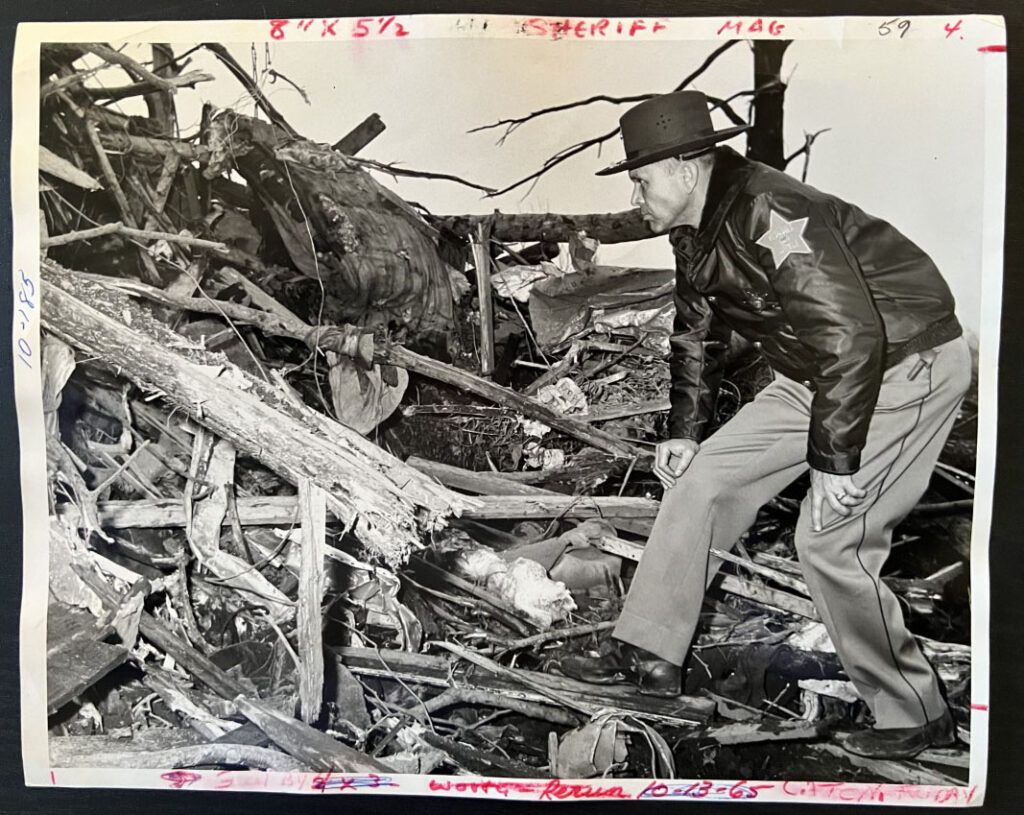
Gene Coney of the Concord Township Fire Department said, “And the next thing you know … the stars came out, and it was beautiful if you looked up. It wasn’t beautiful if you looked down.”
President Lyndon Johnson came to survey the damage later in the week. He said, “I’ve never seen such complete destruction before.”
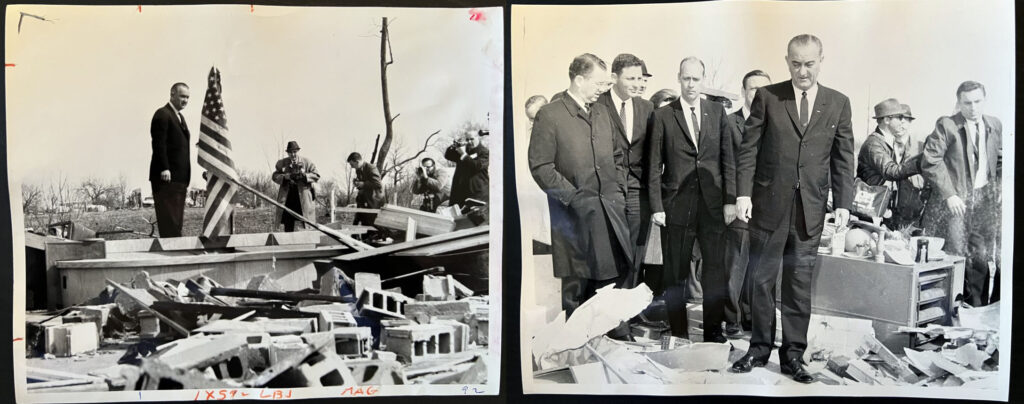
And Huffman was there with all of them.
His iconic photo of the twin funnels – the first ever captured on film – won first place for news when the Inland Press Association gathered at Northwestern University in October 1965. In May 1966, the picture took top prize in the Indiana Associated Press spot news category.
The New York Times called the photo “remarkable.”
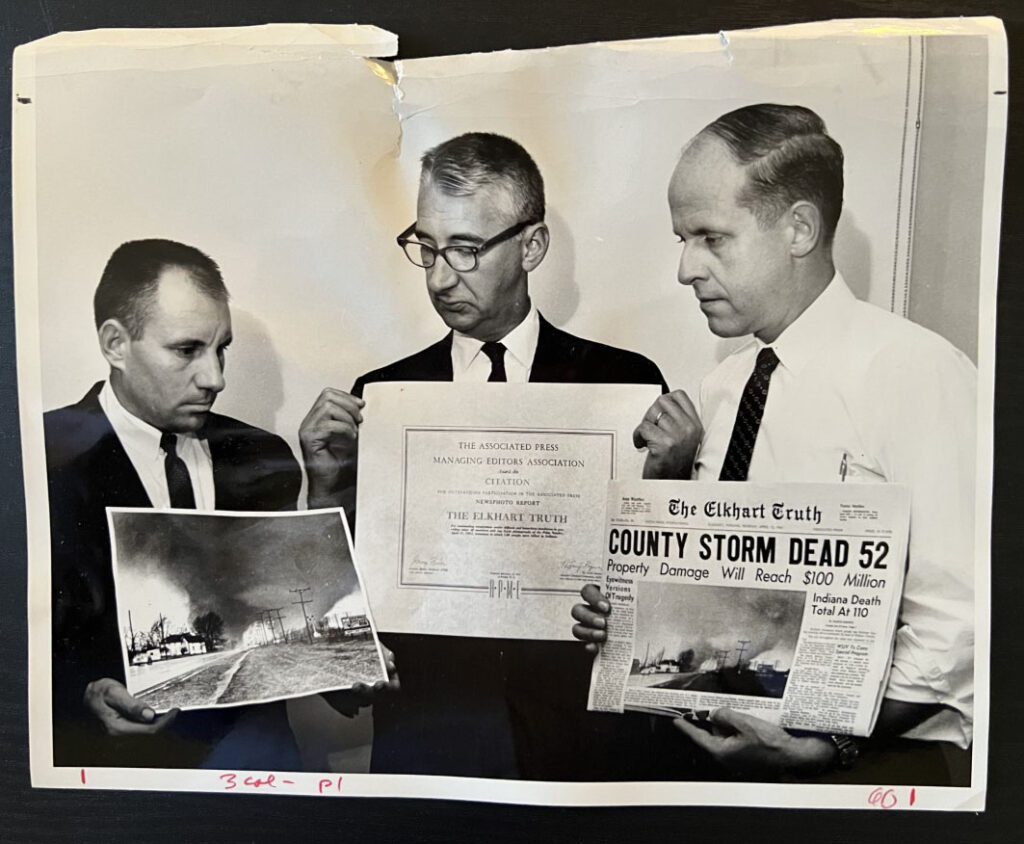
After the storm
When Dr. Ted Fujita of the University of Chicago came to Elkhart County to study the Palm Sunday storm, he interviewed Paul and Betty at their home. Fujita used his findings in developing the international classification scale for tornado intensity that still bears his name.
If the scale had been in place on April 11, 1965, it’s reasonable to believe almost half of the 38 tornadoes that touched down across six states that day were in the F4 or F5 category – the most violent.
Huffman was maybe a half-mile from where the tornadoes touched down when he took his photo. Debris swirled overhead, and both Paul and Betty talked of a car they saw flip and tumble not far from where they parked.
“That brief period (of time) could have cost the news photographer his life,” The Truth printed on May 16, 1966. “Instead, it continues to bring him honors.”